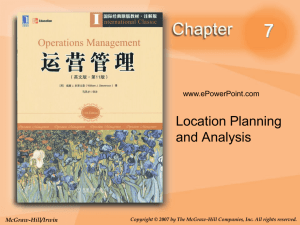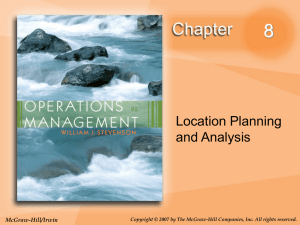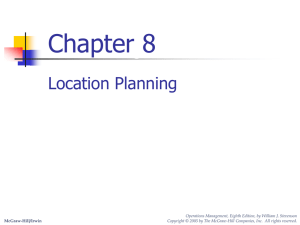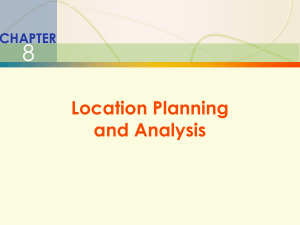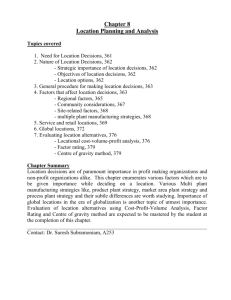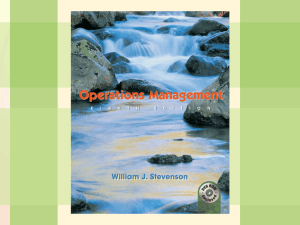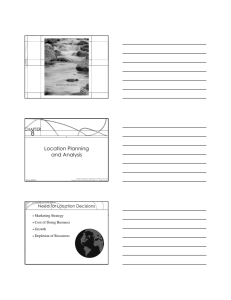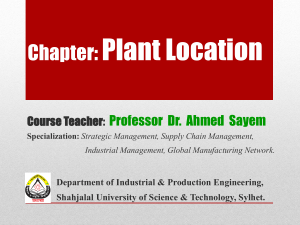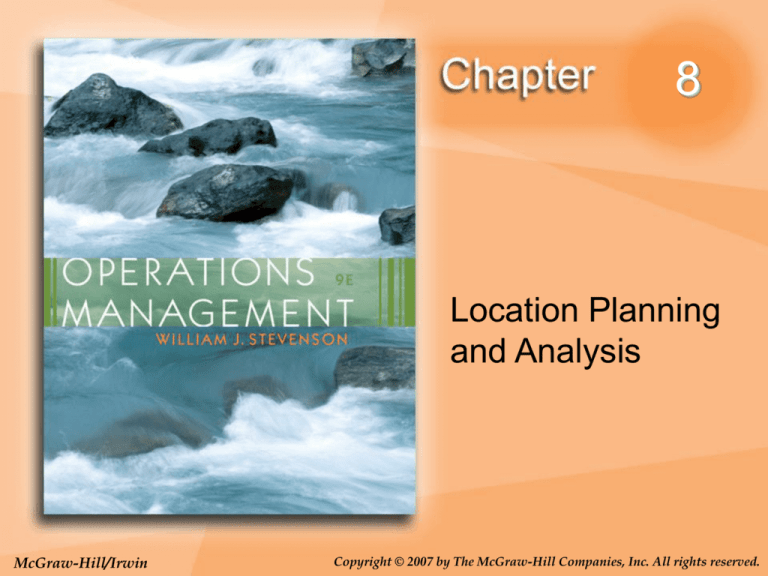
8
Location Planning
and Analysis
McGraw-Hill/Irwin
Copyright © 2007 by The McGraw-Hill Companies, Inc. All rights reserved.
Learning Objectives
Discuss importance of location decisions.
Discuss factors that influence location
decisions.
Discuss recent location trends.
Use techniques to solve typical location
problems:
Cost-Profit-Volume Analysis.
Center of Gravity Method.
8-2
Location Planning and Analysis
Location planning is the determination of
where to geographically locate your
manufacturing or service facilities.
Typically one of the most infrequent
activities unless you work for a retail
organization that is rapidly expanding
(e.g. Starbucks)
8-3
Need for Location Decisions
Marketing Strategy
Cost of Doing Business
Growth
Depletion of Resources
8-4
Nature of Location Decisions
Strategic Importance of location decisions
Long term commitment/costs
Impact on investments, revenues, and operations
Supply chains
Objectives of location decisions
Profit potential
No single location may be better than others
Identify several locations from which to choose
Location Options
Expand existing facilities
Add new facilities
Move
8-5
Making Location Decisions
Decide on the criteria
Identify the important factors
Develop location alternatives
Evaluate the alternatives
Identify general region
Identify a small number of community
alternatives
Identify site alternatives
Evaluate and make selection
8-6
Location Decision Factors
Regional Factors
Community
Considerations
Multiple Plant
Strategies
Site-related
Factors
8-7
Regional Factors
Location of raw materials
Location of markets
Labor factors
Climate and taxes
8-8
Community Considerations
Quality of life
Services
Attitudes
Taxes
Environmental regulations
Utilities
Developer support
8-9
Site Related Factors
Land
Transportation
Environmental
Legal
8-10
Multiple Plant Strategies
Product plant strategy
Market area plant strategy
Process plant strategy
8-11
Service and Retail Locations
Manufacturers – cost focused
Service and retail – revenue focused
Traffic volume and convenience most important
Demographics
Age
Income
Education
Location, location, location
Good transportation
Customer safety
8-12
Comparison of Service and
Manufacturing Considerations
Table 8.2
Manufacturing/Distribution
Service/Retail
Cost Focus
Revenue focus
Transportation modes/costs
Demographics: age,income,etc
Energy availability, costs
Population/drawing area
Labor cost/availability/skills
Competition
Building/leasing costs
Traffic volume/patterns
Tax rebates and other incentives
Customer access/parking
8-13
Trends in Locations
Foreign producers locating in U.S.
“Made in USA”
Currency fluctuations
Just-in-time manufacturing techniques
Microfactories
Information Technology
8-14
Global Locations
Reasons for globalization
Benefits
Disadvantages
Risks
Global operations issues
8-15
Globalization
Facilitating Factors
Trade agreements
Technology
Benefits
Markets
Cost savings
Legal and regulatory
Financial
8-16
Globalization
Disadvantages
Transportation costs
Security
Unskilled labor
Import restrictions
Criticisms
Risks
Political
Terrorism
Legal
Cultural
8-17
Evaluating Locations
Cost-Profit-Volume Analysis
Determine fixed and variable costs
Plot total costs
Determine lowest total costs
8-18
Location Cost-Volume Analysis
Assumptions
Fixed costs are constant
Variable costs are linear
Output can be closely estimated
Only one product involved
8-19
Example 1: Cost-Volume Analysis
Fixed and variable costs for
four potential locations
L o c a tio n
A
B
C
D
F ix e d
C ost
$ 2 5 0 ,0 0
1 0 0 ,0 0
1 5 0 ,0 0
2 0 0 ,0 0
0
0
0
0
V a r ia b le
C ost
$11
30
20
35
8-20
Example 1: Solution
Fixed
Costs
A
B
C
D
$250,000
100,000
150,000
200,000
Variable
Costs
$11(10,000)
30(10,000)
20(10,000)
35(10,000)
Total
Costs
$360,000
400,000
350,000
550,000
8-21
Example 1: Solution
$(000)
800
700
600
500
400
300
200
100
0
0
D
B
C
A
A Superior
C Superior
B Superior
2
4
6
8
10
12
14
16
Annual Output (000)
8-22
Center of Gravity Method
Used to determine location when
minimizing shipping costs or
travel time is the primary
objective.
8-23
Center of Gravity Method
Identify destinations using a coordinate system (x and y axis).
y axis
6
5
(4,5)
4
3
(2,3)
2
(5,2)
1
(1,1)
1
2
3
4
5
6
x axis
If all weights are equal then:
x
x
i
n
y
y
i
n
(1 2 4 5)
3
4
(1 3 5 2)
2.75
4
8-24
Center of Gravity Method
Identify destinations using a coordinate system (x and y axis).
y axis
Destination Number of Trips
(1,1)
10
(2,3)
20
(4,5)
30
(5,2)
20
6
5
(4,5)
4
3
(2,3)
2
(5,2)
1
(1,1)
1
2
3
4
5
6
x axis
If all weights are not equal then:
x Q 1(10) 2(20) 4(30) 5(20) 270
x
3.375
10 20 30 20
80
Q
y Q 1(10) 3(20) 5(30) 2(20) 260
y
3.25
10 20 30 20
80
Q
i
i
i
i
i
i
8-25

